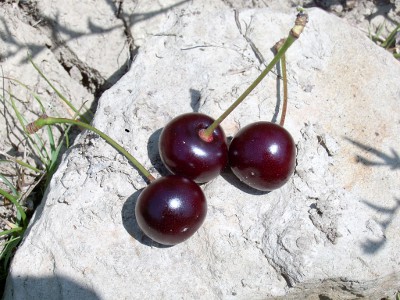︎︎︎ VISCIOLA

La specie è quella del ciliegio acido, Prunus cerasus. Ritrovata in Umbria nelle zone di Pietralunga (PG) e in Val Nerina nel comune di Vallo di Nera (PG), in piante singole, era in passato diffusa in tutta la regione, e presente anche sul versante marchigiano. Questa varietà, come quasi tutta la specie Prunus cerasus, è particolarmente rustica e adatta a stazioni di alta collina e montagna, in terreni anche marginali. Anche se di seconda grandezza, l’albero vigoroso, di forma irregolare e a portamento espanso, con rami ricadenti; fiorisce tardivamente, nella seconda decade di aprile. Ha una notevole tendenza alla formazione di polloni radicali che servono a produrre nuove piante; infatti tradizionalmente non viene innestato. Pur essendo molto rustico, si avvale di terreni freschi e profondi. Poco sensibile alla Monilia. Il frutto di piccole dimensioni, ha forma sferoidale schiacciata ai poli. Il peduncolo è molto lungo inserito in una cavità profonda. Il colore della buccia è rosso molto scuro e così anche è colorata la polpa che è aderente al nocciolo e non troppo consistente. Il succo, abbondante e rosso intenso, è caratteristicamente acidulo. Si raccoglie tardivamente, nella terza decade di luglio, ma la maturazione è un po’ scalare. Questa ciliegia acida è da consumare solo trasformata e ha molti usi. La sua ricchezza in antiossidanti ne fa un frutto prezioso, adatta alle composte e marmellate. Servono anche nella preparazione di vino aromatizzato (visciolato).
It belongs to the sour cherry species, (Prunus Cerasus). It was recovered in the areas of Pietralunga (Perugia), and Val Nerina, in a place called Vallo di Nera (also Perugia), from individual plants. In the past it was common in all of Umbria and was also present in the Marche side of the Appennines. This variety, as almost all the other ones of the species Prunus cerasus, is particularly hardy and suitable for high elevations areas, and poor soil. A tree of medium size, it is vigorous, irregularly shaped, with spreading habit and drooping branches. It blooms late, in the second half of April. It has a strong tendency to sprout root suckers, which are then used to produce new plants. For this reason, it is traditionally not grafted. Although it is quite hardy, it does thrive in rich and deep soil. It is quite resistant to monilinia. It is a small sized fruit, round and flattened at the ends. Its stem is very long and inserted in a deep cavity. Its skin is a very deep red and so is its flesh, being adherent to the pit and soft. Its juice, abundant and intense red, is typically sour. Harvesting time comes late, towards the end of July, but ripening is somewhat in stages. This sour cherry can only be eaten after being preserved and it has many uses. Being rich in antioxidants, it is very valuable and good for making compotes and jams. Traditionally, it is prepared by compressing the stemless cherries with sugar in closed jars, which are then left in the sun for 40 days. After this time they are more or less reduced in syrup. They are ideal with ice cream and the syrup diluted with water makes a very quenching beverage. These cherries are also used to prepare aromatic wine (called “visciolato”).